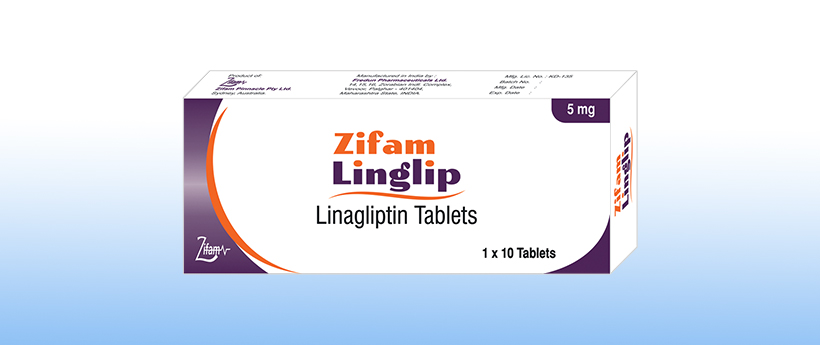Zifam Linglip
- ENG
- မြန်မာ

Each Film coated tablet contains:
Linagliptin ………………….. 5 mg
Excipients: q.s.
Colours: Red Oxide of Iron, Titanium Dioxide BP.
Pharmacological action:
Linagliptin is an inhibitor of the enzyme DPP-4 (Dipeptidyl peptidase 4, EC3.4.14.5) an enzyme which is involved in the inactivation of the incretin hormones GLP-1 and GIP (glucagon-like peptide-1, glucose dependent insulinotropic polypeptide). These hormones are rapidly degraded by the enzyme DPP-4.
Linagliptin binds very effectively to DPP-4 in a reversible manner and thus leads to a sustained increase and a prolongation of active incretin levels.
Linagliptin glucose-independently increases insulin secretion and lawars glucagon secre11on thus resulting in an overall improvement in the glucose homeostasis. Linagliptin binds selectively to DPP-4 and exhibits a> 10,000 fold selectivity versus DPP.a or DPP.a activity in vitro.
Therapeutic category :
Drugs used in diabetes; dipeptidyl peptidase 4(DPP-4) inhibitor.
Therapeutic indication:
Zifam Linglip is indicated in the treatment of type 2 diabetes mellitus to improve glycaemic control in adults:
As monotherapy
• In patients inadequately controlled by diet and exercise alone and for whom metformin is inappropriate due to intolerance, or contraindicated due to renal impairment.
Aa combination therapy
• In combination with metformin when diet and exercise plus metformin alone do not provide adequate glycaemic control.
• In combination with a sulphonylurea and metformin when diet and exercise plus dual therapy with these medicinal products do not provide adequate glycaemic control.
• In combination with insulin with or without metformin, when this regimen alone, with diet and exercise, does not provide adequate glycaemic control.
Posology and method of administration:
The dose of linagliptin is 5mg once daily. When linagliptin is added to metformin, the dose of metformin should be maintained, and linagliptin administered concomitantly.
When linagliptin is used in combination with a sulphonylurea or with insulin, a lower dose of the sulphonylurea or insulin, may be considered to reduce the risk of hypoglycaemia.
For patients with renal and hepatic impairment, no dose adjustment for Zifam Linglip is required.
No dose adjustment is necessary based on age. However, clinical experience in patients > 80 years of age is limited and caution should be exercised when treating this population.
Method of administration: Zifam Linglip can be taken with or without a meal at any time of the day. If a dose is missed, it should be taken as soon as the patient remembers. A double dose should not be taken on the same day.
Contraindications:
Hypersensitivity to the active substance or to any of the excipients or history of a serious hypersensitivity reaction, including anaphylactic reaction, anaphylactic shock, and angioedema, to any dipeptidyl-peptidase-4 (DPP-4) inhibitor.
Warnings and precautions:
Zifam Linglip should not be used in patients with type 1 diabetes or for the treatment of diabetic ketoacidosis.
Linagliptin alone showed a comparable incidence of hypoglycaemia.
When linagliptin was added to a sulphonylurea (on a background of metformin), the incidence of hypoglycaemia was increased over that of placebo. Sulphonylureas and insulin are known to cause hypoglycaemia. Therefore, caution is advised when linagliptin is used in combination with a sulphonylurea and/or insulin. A dose reduction of the sulphonylurea or insulin, may be considered.
Use of DPP-4 inhibitors has been associated with a risk of developing acute pancreatitis. If pancreatitis is suspected, Zifam Linglip should be discontinued; if acute pancreatitis is confirmed, Zifam Linglip should not be restarted. Caution should be exercised in patients with a history of pancreatitis.
Adverse effects:
The most frequently reported adverse reaction was hypoglycaemia observed under the triple combination, linagliptin plus metformin plus sulphonylurea 14.6% versus 7.6% in placebo. In the placebo-controlled studies 6.2% of patients experienced hypoglycaemia as an adverse reaction under linagliptin. Of these, 5.1% were mild and 1.0% were moderate and 0.1% were classified as severe.
Pancreatitis was reported more often in patients randomized to linagliptin.
Drug interactions:
Linagliptin is not an inducer of CYP isozymes.
In vivo interaction studies, linagliptin is considered unlikely to cause interactions with other P-gp substrates.
Co-administration of multiple three times daily doses of 850mg metformin with 10mg linagliptin once daily did not clinical meaningfully alter the pharmacokinetics of linagliptin in healthy volunteers.
Clinically relevant interactions would not be expected with other P-glycoprotein/CYP3A4 inhibitors. Multiple daily doses of linagliptin had a minimal effect on the steady-state pharmacokinetics of simvastatin, a sensitive CYP3A4 substrate, in healthy volunteers.
Following administration of a supratherapeutic dose of 10mg linagliptin concomitantly with 40mg of simvastatin daily for 6 days, the plasma AUC of simvastatin was increased by 34%, and the plasma Cmax by 10%.
Co-administration with 5mg linagliptin did not alter the steady-state pharmacokinetics of levonorgestrel or ethinylestradiol.
Overdosage:
Symptoms: During controlled clinical trials in healthy subjects, single doses of up to 600mg linagliptin (equivalent to 120 times the recommended dose) were generally well tolerated. There is no experience with doses above 600mg in humans.
Management: In the event of an overdose, it is reasonable to employ the usual supportive measures, e.g., remove unabsorbed material from the gastrointestinal tract, employ clinical monitoring and institute clinical measures if required.
Pharmaceutical information:
Storage Conditions:
Store in a cool and dry place below 30°C.
Protect from light and moisture.
Keep Medicine away from children.
Shelf Life: 36 months
Pack size: Blister pack of 10 tablets
Updated on 9/Feb/2024





